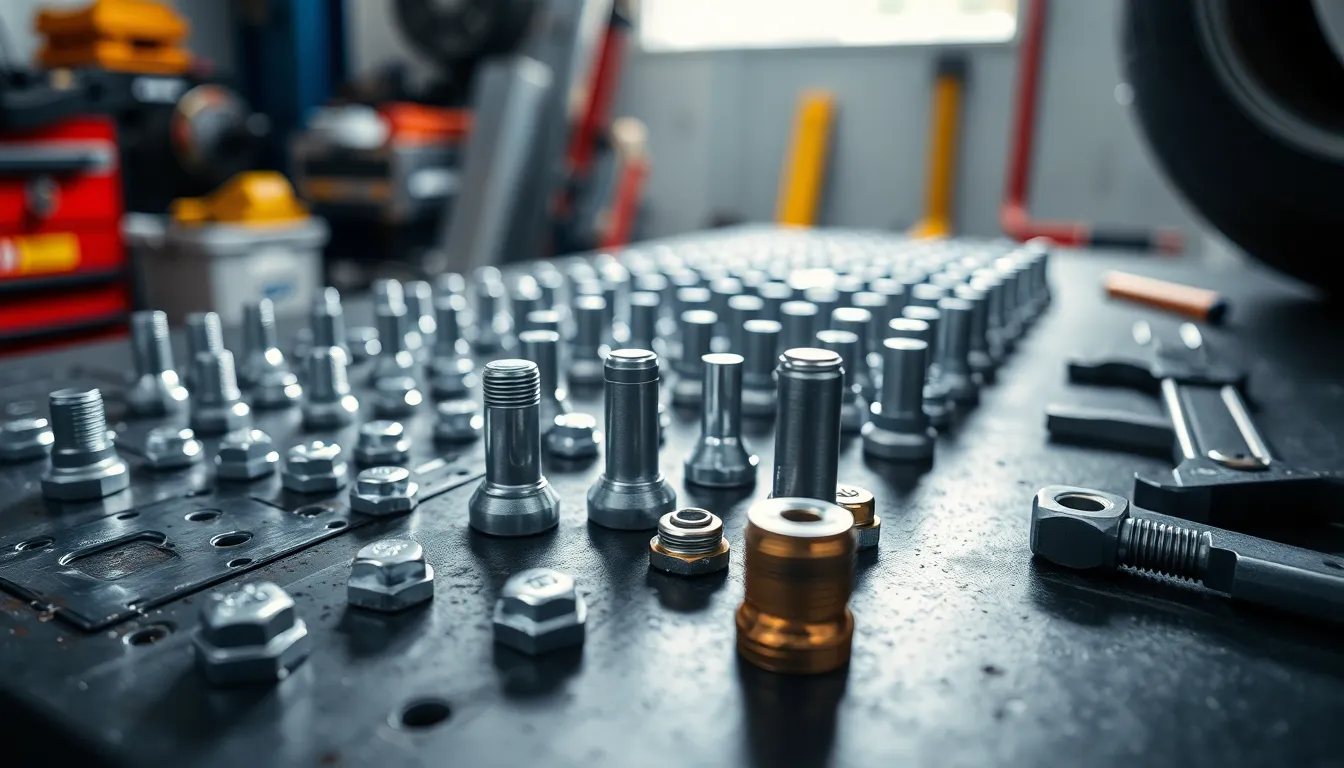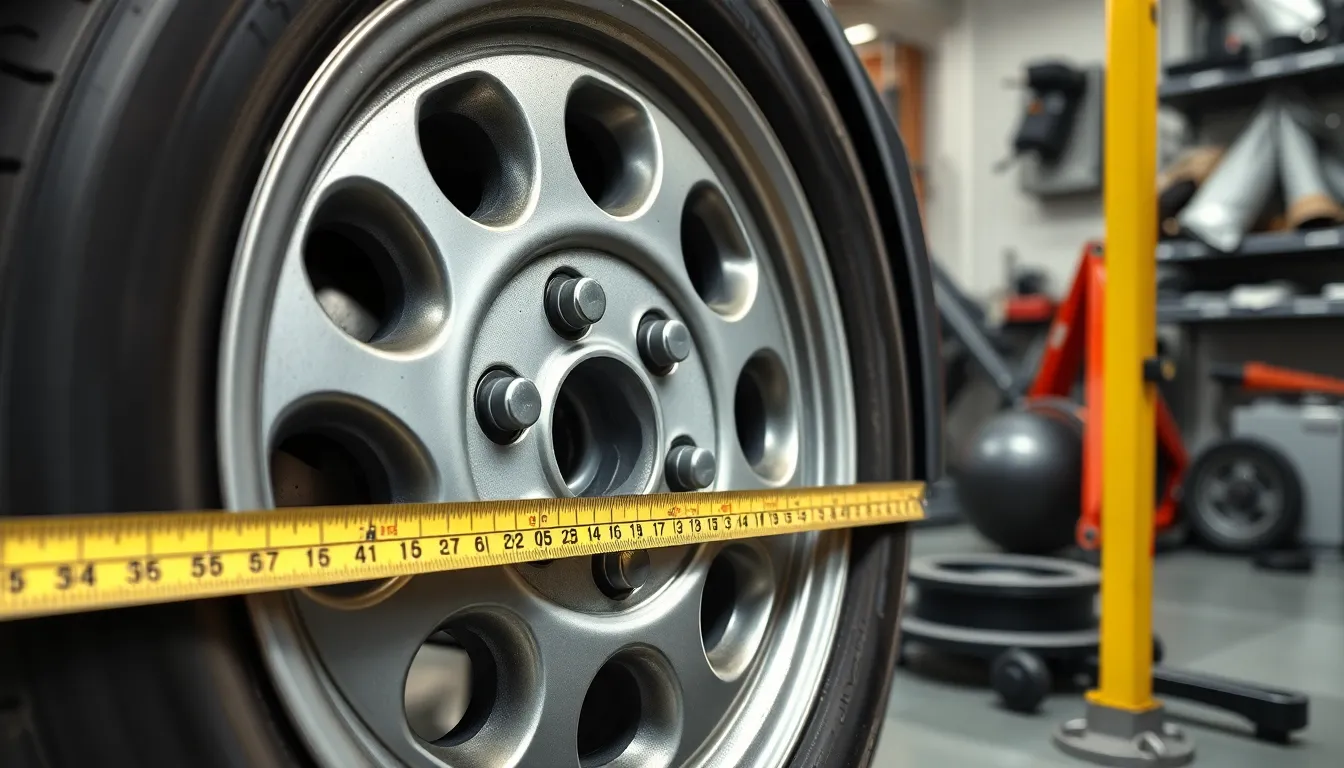Ever wondered why some wheels fit perfectly on certain vehicles while others don’t? The secret lies in understanding wheel bolt patterns – a crucial specification that determines wheel compatibility and safety.
We’ve all been there: you find the perfect set of wheels for your ride only to discover they won’t fit. That’s where bolt pattern knowledge becomes your best friend. This measurement system tells you exactly which wheels will work with your vehicle’s hub and which ones you should avoid.
Whether you’re upgrading to aftermarket wheels or replacing damaged ones understanding bolt patterns saves you time money and potential safety hazards. We’ll break down everything you need to know about this essential automotive specification so you can make confident wheel choices every time.
What Is Wheel Bolt Pattern
Wheel bolt pattern represents the exact arrangement of bolt holes on a vehicle’s wheel hub. The pattern determines how many bolts secure the wheel and measures the diameter of the circle that passes through each bolt hole center.
Two primary measurements define every bolt pattern:
| Component | Description | Example |
|---|---|---|
| Bolt count | Number of bolts or studs | 4, 5, 6, 8 bolts |
| Pitch circle diameter (PCD) | Distance across bolt hole centers | 4.5″, 5.0″, 5.5″ inches |
Manufacturers express bolt patterns using standardized notation like 5×114.3 or 5×4.5. The first number indicates bolt count while the second represents the pitch circle diameter in millimeters or inches.
Common bolt patterns include:
- 4x100mm – Found on compact cars like Honda Civic and Toyota Corolla
- 5×114.3mm – Standard for mid-size vehicles including Ford F-150 and Honda Accord
- 5x120mm – Used by BMW and some General Motors vehicles
- 6×139.7mm – Popular on full-size trucks and SUVs
Different vehicles use varying bolt patterns based on weight requirements and structural design. Passenger cars typically feature 4 or 5 bolt patterns while heavy-duty trucks often use 6 or 8 bolt configurations for increased load capacity.
Bolt pattern compatibility affects wheel fitment directly. Wheels with incorrect patterns won’t mount properly regardless of other matching specifications like diameter or offset. Understanding your vehicle’s exact bolt pattern prevents purchasing incompatible wheels and ensures proper installation.
How to Measure Wheel Bolt Pattern

Measuring your wheel bolt pattern accurately ensures proper wheel fitment and vehicle safety. Two distinct methods exist depending on the number of bolt holes on your wheel.
4-Lug and 6-Lug Patterns
Even numbered bolt patterns like 4-lug and 6-lug configurations use the straight-across measurement method. Measure the distance between the centers of two opposite lug holes to determine the pitch circle diameter. This direct measurement provides the exact PCD value you need for wheel compatibility.
4-lug patterns typically appear on compact cars and smaller vehicles where weight distribution requirements allow for fewer mounting points. Compact sedans and economy vehicles commonly use 4x100mm or 4x108mm configurations.
6-lug patterns strengthen the wheel connection for larger vehicles requiring additional load capacity. Pickup trucks and mid-size SUVs frequently feature 6×139.7mm bolt patterns to handle increased weight and torque loads.
5-Lug and 8-Lug Patterns
Odd numbered bolt patterns require a different measurement approach due to their asymmetrical layout. Measure from the back edge of one lug hole to the center of the hole positioned directly across from it. This method compensates for the fact that no bolt hole sits directly opposite another in odd numbered configurations.
5-lug patterns dominate the passenger vehicle market with widespread adoption across sedans, crossovers, and sports cars. Most manufacturers use 5×114.3mm for mid-size vehicles, while BMW typically employs 5x120mm specifications. These patterns balance structural strength with manufacturing efficiency.
8-lug patterns serve heavy duty applications where maximum strength becomes essential. Full-size pickup trucks and commercial vehicles use 8×165.1mm or 8x170mm patterns to distribute substantial loads across more mounting points. These configurations handle the extreme forces generated by towing and hauling operations.
Common Wheel Bolt Patterns by Vehicle Type

Different vehicle categories use distinct bolt patterns based on their weight requirements and structural demands. We’ve organized the most prevalent patterns by vehicle type to help you identify what works for your exact automobile.
Passenger Cars
Passenger cars typically feature four or five lug holes in their wheel bolt patterns. The 4x100mm pattern dominates compact car applications, providing adequate strength for lighter vehicles while maintaining cost effectiveness. Mid-size sedans and many popular models use the 5×114.3mm pattern, which offers enhanced load distribution across five mounting points.
Sports cars often employ the 5x120mm configuration for increased structural integrity during high-performance driving. European luxury sedans frequently use 5x112mm patterns, particularly in German automotive applications. Asian manufacturers commonly standardize on 4x100mm for economy vehicles and 5×114.3mm for larger passenger cars.
Trucks and SUVs
Trucks and SUVs require more robust mounting systems with five or more lug holes to handle increased weight and towing demands. The 6×139.7mm pattern appears extensively across full-size pickup trucks from major American manufacturers. Half-ton trucks often use 6x135mm configurations, while heavy-duty applications employ 8×165.1mm patterns for maximum load capacity.
SUVs share many patterns with their truck counterparts, with 6×139.7mm being particularly common in body-on-frame designs. Crossover vehicles frequently use 5×114.3mm patterns since they’re built on passenger car platforms. Large SUVs designed for towing capabilities typically feature 6-lug or 8-lug configurations to distribute stress effectively.
European vs. Domestic Patterns
European manufacturers primarily use metric measurements in their bolt pattern specifications. Common European patterns include 5×114.3mm, 4x100mm, and 5x120mm for BMW applications. German brands often standardize on 5x112mm across multiple model lines, creating parts compatibility within manufacturer ecosystems.
Domestic American patterns traditionally used imperial measurements like 5×4.5 inches or 6×4.5 inches. Converting these measurements reveals that 5×4.5 inches equals 5×114.3mm, while 6×4.5 inches translates to 6×114.3mm. Modern American vehicles increasingly adopt metric specifications to align with global manufacturing standards and improve international parts availability.
Why Wheel Bolt Pattern Matters

Understanding why wheel bolt patterns matter extends beyond simple compatibility concerns. We must recognize that the bolt pattern directly influences both vehicle safety and overall performance characteristics.
Safety Considerations
The correct wheel bolt pattern ensures that lug nuts lock wheels securely to the vehicle hub. This secure connection prevents wheel loss while driving, which can result in catastrophic accidents and pose serious risks to both drivers and other road users.
Mismatched bolt patterns create dangerous scenarios where wheels may appear properly mounted but lack adequate securing force. The lug nuts won’t distribute clamping force evenly across the wheel surface when the bolt pattern doesn’t match precisely. This uneven distribution can cause gradual loosening during normal driving conditions.
Vehicle manufacturers engineer exact bolt patterns to handle the weight and stress loads of each vehicle type. Installing wheels with incorrect bolt patterns compromises this engineered safety margin and can lead to sudden wheel failure. The consequences of wheel detachment at highway speeds include loss of vehicle control, damage to the vehicle’s suspension components, and potential injury to occupants and nearby vehicles.
Performance Impact
Bolt pattern compatibility affects vehicle performance through proper wheel fitment and load distribution. Correctly matched patterns ensure optimal contact between the wheel and hub, maintaining the vehicle’s designed handling characteristics and stability.
Incorrect bolt patterns reduce the wheel’s ability to transfer steering inputs effectively from the hub to the tire contact patch. This reduced transfer capability results in imprecise steering response and diminished overall vehicle control. The misalignment also creates vibrations that travel through the suspension system, affecting ride quality and driver comfort.
Proper bolt pattern matching enhances the performance of aftermarket wheel upgrades by maintaining the manufacturer’s intended weight distribution and rotational balance. When the pattern aligns correctly, the wheel centers precisely on the hub, preserving the vehicle’s suspension geometry and ensuring that performance modifications deliver their intended benefits rather than creating new handling issues.
How to Find Your Vehicle’s Bolt Pattern

We can determine our vehicle’s wheel bolt pattern through several reliable methods. These approaches range from consulting existing documentation to performing precise measurements.
Owner’s Manual and Documentation
Owner’s manuals provide the most straightforward method for finding bolt pattern specifications. Vehicle documentation typically lists this information under wheel or tire specifications since manufacturers recognize bolt patterns as essential for proper wheel fitment. We can also locate bolt pattern data on the vehicle identification placard found inside the driver’s door jamb or glove compartment. Registration documents and maintenance records sometimes include this specification when wheel service was previously performed.
Physical Measurement Methods
Physical measurement offers accurate bolt pattern determination when documentation isn’t available. We measure differently based on the number of lug holes present on our wheels.
For even numbered patterns like 4 lug and 6 lug configurations we measure straight across from the center of one lug hole to the center of the opposite hole. This direct measurement gives us the pitch circle diameter immediately.
For odd numbered patterns including 5 lug arrangements we measure from the back edge of one lug hole to the center of the lug hole positioned two spaces away. This technique accounts for the geometric impossibility of measuring directly across in odd numbered configurations.
We express our final measurement as the number of lugs followed by the diameter measurement. Common results include 5×114.3mm for mid size vehicles or 4x100mm for compact cars.
Online Resources and Databases
Online databases provide comprehensive bolt pattern information organized by vehicle make model and year. Wheel manufacturer websites often feature bolt pattern lookup tools that cross reference our vehicle specifications with compatible wheel options. Automotive parts retailers maintain searchable databases linking vehicle information to appropriate bolt patterns for quick verification.
We can access tire shop websites that offer bolt pattern finders requiring only our vehicle’s year make and model for instant results. Forums and enthusiast communities also compile bolt pattern charts covering multiple vehicle generations and trim levels.
Bolt Pattern Compatibility and Adapters

Compatibility issues arise when aftermarket wheels feature bolt patterns that don’t match our vehicle’s hub configuration. Adapters and spacers provide answers for these fitment challenges, allowing us to install wheels with different bolt pattern specifications.
When Patterns Don’t Match
Mismatched bolt patterns create serious safety concerns that extend beyond simple fitment problems. Installing wheels with incorrect bolt patterns without proper adapters can lead to improper wheel securing, as the lug nuts may not align correctly with the hub mounting points. This misalignment prevents the wheels from achieving proper contact with the vehicle hub, creating uneven clamping force distribution.
Safety issues escalate when wheels aren’t secured properly to the vehicle because gradual loosening occurs over time. The incorrect pattern prevents lug nuts from maintaining consistent torque specifications, increasing the risk of wheel detachment during operation. We must ensure compatibility before installing new wheels to prevent these potentially catastrophic failures.
Using Wheel Spacers and Adapters
Spacers adjust wheel positioning by adding space between the wheel and hub, compensating for differences in bolt pattern dimensions. These components maintain the original bolt pattern while changing the wheel’s offset and positioning relative to the vehicle’s body. Spacers work best when the bolt patterns match but additional clearance is required for proper fitment.
Adapters provide more comprehensive answers by changing the bolt pattern from the vehicle’s hub to match the desired wheel specifications. These components feature one bolt pattern on the hub side and a different pattern on the wheel side, allowing installation of wheels with completely different lug hole arrangements. Adapters enable us to use wheels with different numbers of lug holes or varying pitch circle diameters than our vehicle’s original configuration.
Professional installation ensures proper torque specifications and safety compliance when using either spacers or adapters. These components must meet exact thickness and strength requirements to handle the vehicle’s weight and performance demands safely.
Conclusion
Understanding wheel bolt patterns isn’t just technical knowledge—it’s essential for safe driving and smart purchasing decisions. We’ve covered how to identify your vehicle’s exact pattern and why proper fitment matters for both safety and performance.
Whether you’re upgrading to aftermarket wheels or replacing damaged ones the key is ensuring compatibility before making any purchase. Remember that mismatched patterns can lead to serious safety risks including wheel detachment.
Take the time to measure accurately or consult reliable resources when selecting new wheels. Your vehicle’s bolt pattern is the foundation of secure wheel installation and optimal performance. When in doubt always seek professional guidance to ensure you’re making the right choice for your exact vehicle.
Frequently Asked Questions
What is a wheel bolt pattern?
A wheel bolt pattern represents the arrangement of bolt holes on a vehicle’s wheel hub. It’s defined by two measurements: the number of bolts or studs, and the pitch circle diameter (PCD), which measures the distance across bolt hole centers. This pattern determines wheel compatibility and is expressed in standardized notation like 5×114.3mm.
How do I measure my vehicle’s bolt pattern?
For even-numbered patterns (4-lug, 6-lug), measure straight across between the centers of two opposite holes. For odd-numbered patterns (5-lug, 8-lug), measure from the back edge of one hole to the center of the hole directly across. Use precise measuring tools for accuracy.
Why are wheel bolt patterns important for safety?
Correct bolt patterns ensure lug nuts securely lock wheels to the hub, preventing wheel loss and accidents. Mismatched patterns create uneven clamping force, causing gradual loosening and increasing the risk of wheel detachment, especially at high speeds. Proper fitment is essential for vehicle safety.
What are the most common bolt patterns?
Common patterns include 4x100mm for compact cars, 5×114.3mm for mid-size vehicles, 5x120mm for BMWs and sports cars, 5x112mm for European luxury sedans, and 6×139.7mm for full-size trucks and SUVs. The 5-lug pattern dominates the passenger vehicle market.
Can I use wheels with different bolt patterns?
Using mismatched bolt patterns creates serious safety risks. However, wheel adapters and spacers can resolve compatibility issues when properly installed. Professional installation is recommended to ensure safety compliance and proper torque specifications. Always verify compatibility before installation.
Where can I find my vehicle’s bolt pattern information?
Check your owner’s manual or vehicle documentation first. If unavailable, measure the pattern physically or use online databases from manufacturer websites and automotive parts retailers. These resources provide comprehensive information based on your vehicle’s make, model, and year.
Do bolt patterns affect vehicle performance?
Yes, proper bolt pattern fitment ensures optimal wheel-to-hub contact, maintaining handling characteristics and stability. Incorrect patterns can cause imprecise steering response, vibrations, and poor ride quality. Proper matching is essential for aftermarket wheel upgrades to deliver intended benefits.
What’s the difference between metric and imperial bolt patterns?
European manufacturers primarily use metric measurements (like 5x112mm), while American vehicles traditionally used imperial measurements. However, modern American vehicles are trending toward metric specifications. Understanding these differences is crucial when selecting aftermarket wheels.




